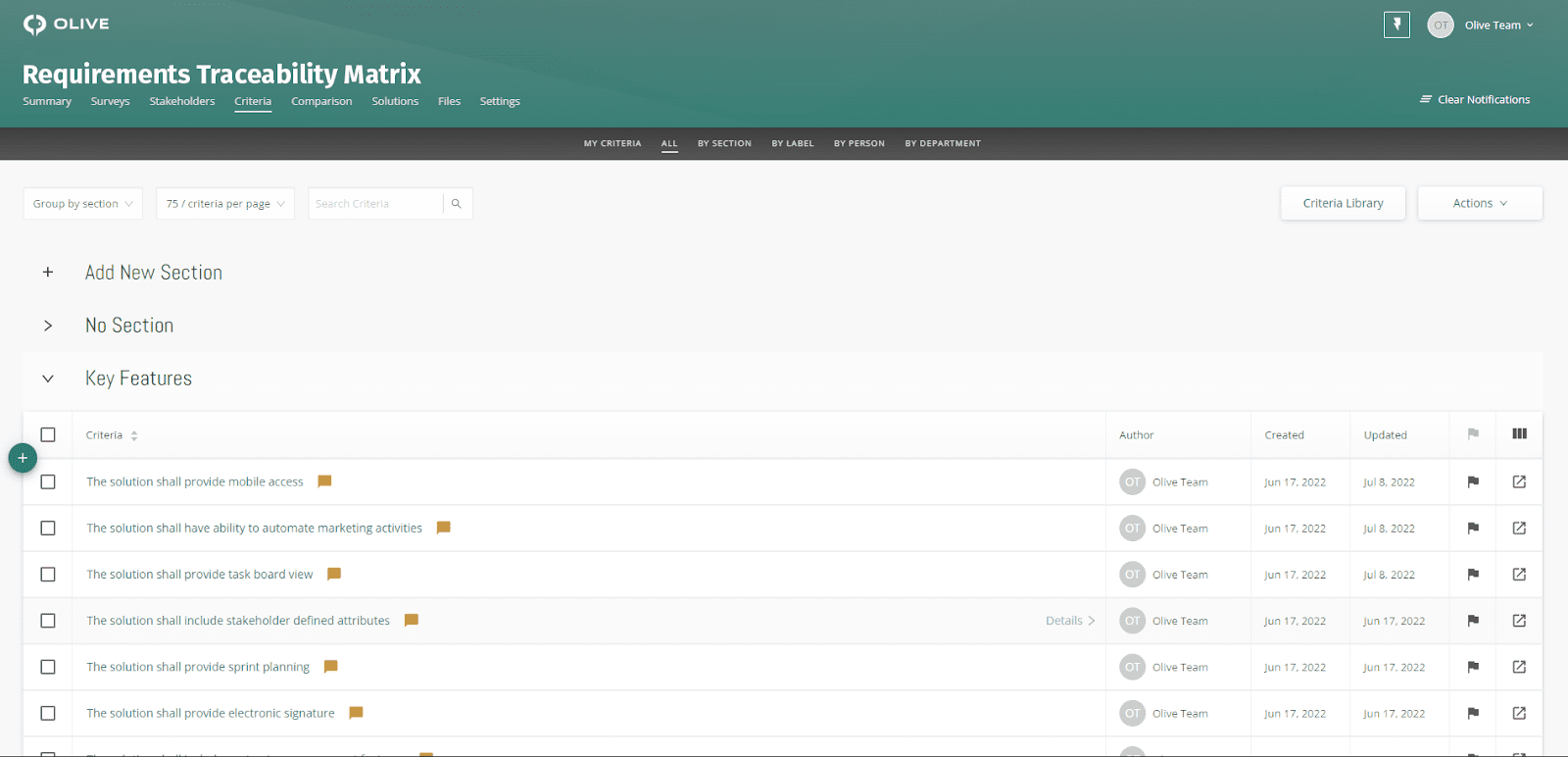Requirements Gathering and Management Techniques for Enterprise Software Selection
Use the right requirements management techniques and reap the benefits of saved time, increased productivity, improved collaboration, alignment, organizational buy-in, and more. Managing requirements for software selection thoroughly and efficiently will lead to the best-fit solution for the organization and the digital transformation benefits it brings.
What is Requirements Management for Software Selection?
Requirements management for software selection is the process of gathering, analyzing, verifying, and validating the needs and requirements for the selected software or system, such as an ERP, HCM, LMS, POS, BI, and AI, to name a few.
Requirements management provides a way to prevent mistakes and errors by tracking changes and enabling a consistent flow of communication with stakeholders from starting a project throughout the lifecycle.
Traditionally, requirements are managed via documents, such as emails and spreadsheets. These days, requirements management tools offer a far more streamlined and efficient process.
What is a Requirements Management Plan (RMP)?
A Requirements Management Plan (RMP) describes the requirements artifacts, requirements types (including attributes), the requirements management process, and the metrics and tools to measure, report, and control changes to the requirements.
The contents of a typical RMP contain the following sections:
- Stakeholder roles and responsibilities
- Requirements management process (elicited, analyzed, documented, and managed)
- Requirements type definition
- Requirements type/artifact mapping
- Naming and numbering convention
- Requirements prioritization
- Requirements traceability
- Requirements versioning
- Requirements baseline (requirements change control)
- Communication strategy for requirement changes
- Requirements management tools
What Requirements Management Techniques Exist Today?
When looking at the existing requirements management techniques, two predominant techniques exist. The traditional Waterfall approach and the Agile approach.
1. Waterfall Requirements Management for Software Selection
Waterfall project management is a way to organize a project by dividing it into distinct phases and completing each phase before moving on to the next. It’s the most traditional project management method, with team members working linearly towards a set end goal. Each participant has a clearly defined role, and none of the phases or goals are expected to change.
This traditional waterfall process of determining needs and comparing them to solution options is difficult, long, flawed, and risk-prone. Not to mention, cobbling tools together (such as spreadsheets and multiple PM tools) to run the process results in shady data and potential human error and bias within the results.
2. Agile Requirements Management for Software Selection
Agile Requirements Management is a flexible approach to requirements gathering. Flexibility means you can easily iterate and make changes to have a more accurate outcome and avoid off-target deliveries and missed deadlines.
Agile requirements gathering is focused on finding the right solution faster while addressing key stakeholders’ needs more accurately.
Collaboration is critical; everyone on the team must understand the business’s true needs and how they affect the decision. Olive offers streamlined requirement management tools to facilitate an agile and automated approach to requirements management.
Facilitating Requirements Gathering (Elicitation) With The Right Stakeholders
Technology Project leaders are important in facilitating requirements gathering with the right stakeholders. Identifying the right stakeholders also helps define and verify the requirements management process. Failure to invest the time and diligence required in collaborating with your stakeholders to determine business needs can lead to choosing the wrong solution, low user adoption rates, the software costing much more than planned, or the solution becoming a piece of shelf-ware.
Working with the right stakeholders can help with the following:
- Highlighting the right business problems to solve
- Identifying crucial features and integrations for the solution
- Avoiding requirement oversights
- Avoiding band-aid solutions
- Evaluating requirements suggested by others
- Ranking priority requirements
- Raising compatibility issues
- Championing the software implementation
- Constructing the best workflow process using the software
- Reduces opportunity cost of choosing the wrong solution
Technology project leaders should keep the following stakeholders in mind throughout the requirements management process:
Stakeholders typically include:
Project sponsor
One of the most crucial stakeholders to elicit requirements from, as their requirements translate into direct project benefits.
Business unit managers
Senior management within the organization, whose areas are directly impacted by requirements. Their viewpoint is a focal point so that the requirements reflect what needs to be delivered to achieve the business benefits.
Department heads
Department heads represent teams who’s work or process will be affected directly or indirectly by the software chosen.
Procurement
Procurement has a stake in sourcing and negotiation, and budgeting purposes. These will be must-have requirements that span multiple solutions.
IT
IT needs thorough input so the chosen solutions work within the existing or proposed architecture of software in the company. They will also have must-have security requirements.
Testing team
This team plays a crucial role in ensuring the test cases can be traced back to each original business requirement, and each one validated.
Solution Architect(s)
Solution Architects are vital to include as stakeholders in the effort to align the requirements toward the finalized end-to-end solution.
Project leaders will also need to work closely with external stakeholders (consultants, voice of customer, other tech vendors) who generally have a vested interest in a project but aren’t directly involved in the development or implementation.
Typically external stakeholders include regulatory or compliance groups that impose strict rules or specific requirements parameters, such as security and procurement standards, to ensure conformity across an industry sector.
Digital Requirements Management Techniques
At Olive, we firmly believe in leveraging agile automation to manage requirements.
Technology has come so far as to facilitate this. The right requirements management techniques in 2023 are digital, and we are not talking about spreadsheets, emails, and zoom calls.
Olive was built to facilitate agile collaboration on requirements management. Our software can easily streamline and automate the requirements management process.
Olive automates requirements traceability and comes with repeatable project templates, allowing you to preload with initial discovery questions, functional requirements, non-functional requirements, and surveys. You can gather, rank, and satisfy requirements through a streamlined platform which greatly shortens the process. Indeed Olive helps you to reduce the margin for error so that your implementation goes exactly as you had visualized in the beginning, keeping all stakeholders and clients aligned.
 Requirements Traceability Matrix in Olive
Requirements Traceability Matrix in Olive
The Best Requirements Management Technique for Software Selection is Here!
Requirements management doesn’t need to be time-consuming or tedious. Undoubtedly, a cloud-based requirements management platform like Olive’s cloud-based requirement management solution facilitates an agile and automated approach to requirements management.
The Benefits of bringing Agile Automation to your Requirements Management Techniques, with Olive
Increased Productivity
Using multiple excel spreadsheets to gather requirements, rank them in meetings, and manage the entire requirements management process across endless PM tools is highly unproductive. Increase your team’s productivity and output with a collaborative requirements-gathering tool. Our Client, Mark Tucker from Kong managed to cut the requirements gathering process down from 2-3 months to 2 weeks, using Olive.
Time Saved Gathering Requirements
Increased Collaboration and Alignment
Olive has one centralized platform to collaborate on requirements ensures that clients are aligned.
Automated Due Diligence
Documenting everything is an important and often overlooked component in requirements management. Olive automates this due diligence, so you can refer back to a requirement ranking or response at the touch of a button to understand where why and how a decision was made.
Increased Buy-in early on Contributes to High User Adoption Post Implementation
Collaborating on requirements with the right stakeholders should be part of your Change Management Strategy. When employees are bought into the decision-making process, it helps them understand why a decision is being made on a company level and increases trust toward digital transformation.




